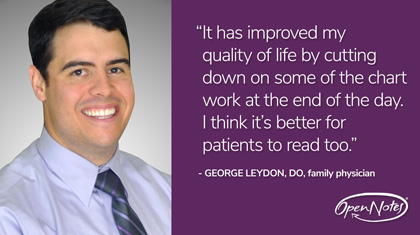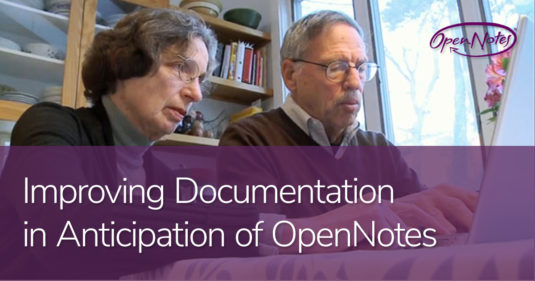
by George Leydon, DO, family physician
MADISON, WI – When our medical director indicated that we’d be implementing OpenNotes this summer, my fleeting concern about patients seeing my typos was quickly superseded by possible downstream increase in workload—clarifications, phone calls about the documentation, etc. My fear was that it could contribute further to charting fatigue.
I’ve read that many who implement OpenNotes don’t initially make changes to documentation practices, though some do make changes over time. I’m trying to see about making changes up front and am happy with the progress over the last two months. It has improved my quality of life by cutting down on some of the chart work at the end of the day. I think it’s better for patients to read too.
I’ve broken up my documentation into the traditional SOAP format, and tried to streamline the text, expecting that patients will see this information. Obviously, your mileage may vary. This works for me in a busy primary care clinic.
Streamlining SOAP When You Know the Patient Is Looking
Subjective: The first thing I do is turn the computer monitor toward the patient. Usually, I wave my hand (not quite like a magician, but you get the idea) as if I’m inviting them to see the screen and see what I’m typing. The subjective portion is shorthand of words, dates, and salient details that the patient reports. This section is not elegant, but when I know what it means and the patient sees that it’s accurate, it is usually adequate.
In certain circumstances I may further elaborate (later) when a detailed history can’t be typed in the room, or during sensitive times when it is critical to give full attention to the patient and not to a computer screen.
Review of Systems (ROS): Once upon a time, I found I was suffering from click fatigue and was accidentally documenting negative ROS when the situation may not have been negative at all. In an effort to be more accurate, I switched to typing out specific details often using abbreviations (e.g., DOE, SOB). After reading suggestions from OpenNotes, I have incorporated Epic’s notewriter feature using “smartblocks” (clicking on boxes rather than free text) to do the review instead. I find that this is deliberate, accurate and readable. It saves time with clear words, not abbreviations.
Objective: Again, I’m steering clear of prewritten documentation (e.g., dot phrases, smart phrases) and using “smartblocks”. This can feel a bit robotic—The left knee is not swollen, the right knee is swollen—but it is clear and readable, which is what matters to patients. Yes, there are a lot of mouse clicks, but I find that it is quick.
Assessment & Plan: I have been typing out a written, easy to understand, plan of actionable items well before the implementation of OpenNotes. This is my formal plan and is copied into the after visit summary, which is often printed out or available on the patient portal. I find this has and continues to work well for my patients and me.
I’m Happy!
I have been using this altered style of documentation for two months, feel that I am not spending additional time documenting, and I am happy.
I don’t always explain OpenNotes to patients, but when I do it takes about five seconds and consistently yields a positive response. Whether my patient will be more engaged, or simply more confident in their care is yet to be determined.
So far, patients at Group Health Cooperative of South Central Wisconsin are just beginning to learn about OpenNotes. It is not yet widespread so the percentage of patients who have read notes through the electronic portal (Epic MyChart) is low.
I’ll keep you posted on my progress and share anecdotes if patients raise concerns in the future.
George Leydon, DO, is a family physician at Group Health Cooperative of South Central Wisconsin. Connect with Dr. Leydon on LinkedIn, and follow him on Twitter at @georgeleydon.

Additional Reading:
Your Patient Is Now Reading Your Note: Opportunities, Problems, and Prospects. Klein, Jared W. et al., The American Journal of Medicine, October 2016, Volume 129, Issue 10, 101 –1021




You must be logged in to post a comment.